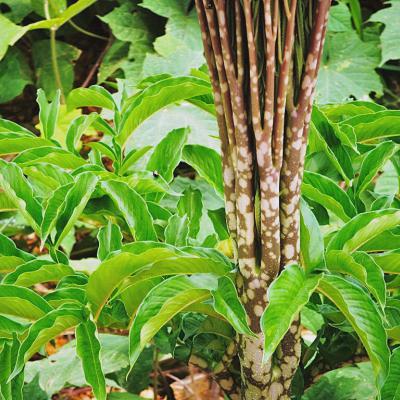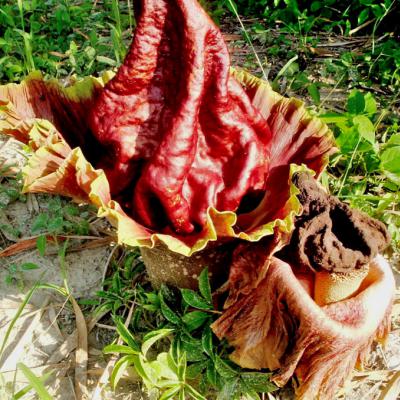Araceae-Amorphophallus-paeoniifolius
Classification
- Botanical Family : Araceae
- Genus : Amorphophallus
- Epithet : paeoniifolius
- German Family Name: Aronstabgewächse
- English Name: Elephant Yam
- Thai Name: บุกคางคก
- Thai Phonetic: puk kaang kok
- Author: (Dennst.) Nicolson
- Height: 1.50
Water Requirements
Plant Type
Light Requirements
Cultivation
The plant grows about 0,80 m high.
The plant has one sizable to large tuber and produce only one pedunculated and palmately divided leaf per year. This fades off to the dry season. The plant is decidouos.
The plant needs constantly moist soil and a partial shade or a shady spot. It prefers loamy or sandy soil.
Propagation: from the mother tuber progeny tubers. These shall remain in the mother tuber, until they dissolve easily and are then potted and grown as separate plants. Sawing is also possible.
The juice of Amorphophallus paeoniifolius is poisonous because it contains calcium oxalate. This cause, if consumed the raw plant parts, irritation to the lips, mouth and throat. It also causes skin irritation in contact with skin.
Amorphophallus paeoniifolius kommt von Madagaskar bis nach Polynesien vor. Es handelt sich um eine Pflanze, die eher nicht als Zierpflanze in Gärten zu finden ist, obwohl sie eine sehr interessante Blüte hat. Sie wächst meistens wild in Wäldern oder im lichten Unterholz in Plantagen. Sie ist eine mehrjährige, stammlose Pflanze. Das, was wie ein Stamm aussieht ist der Blattstiel.
Die Pflanze wächst ca. 0,80 m hoch.
Amorphophallus paeoniifolius hat eine große bis riesige Knolle und pro Jahr ein einziges gestieltes und handförmig geteiltes Blatt. Dieses welkt vor der Trockenzeit ab. Die Pflanze ist nicht immergrün.
Die Blütezeit liegt vor dem Neuaustrieb des Blattes, ist also im blattlosen Zustand austreibend. Die einzige Blüte ist mächtig bis riesig, sitzend, mit trichterförmiger bis aufrecht-glockiger Spatha und schwach konischer, säulenartig herausragender Spadix. Mit dem intensivem Geruch nach Aas lockt die Blüte Fliegen zur Bestäubung an. Die Blüte ist nur für einige Stunden bis zur Bestäubung geöffnet und der üble Geruch nimmt ab. Die Blüte bildet ein großes Hüllblatt, das in eine Farbmischung aus Purpur, Braun und Ocker getaucht ist.
Die Pflanze fühlt sich in stets feuchtem Boden an einem halbschattigen oder schattigen Platz am wohlsten. Sie bevorzugt lehmigen oder sandigen Boden.
Vermehrung: durch Abtrennung der Mutterknolle anhaftende Tochterknollen. Diese sollten solange an der Mutterknolle verbleiben, bis sie sich leicht lösen und danach als separate Pflanzen eingetopft und kultiviert werden. Aussaat ist ebenfalls möglich.
Der Saft von Amorphophallus paeoniifolius ist giftig, weil er Kalziumoxalatkristalle enthält. Er verursacht bei Hautkontakt Hautreizungen. Bei Verzehr der rohen Pflanzenteile bewirkt er Reizungen im Mund, auf Lippen, im Rachen und auf der Zunge.
Origin
Miscelaneous
Use: as food, the tubers, stems and leaves are edible when they were cooked long enough. The toxic calcium oxalate decay by cooking and are therefore not harmful when consumed.
Ethnomedical uses
The ethnomedical information is provided for general information only, it is not intended as guidance for medicinal use.
Verwendung: als Nahrungsmittel werden die Knollen, Blattstiele und Blätter gegessen, wenn sie ausreichend lange gekocht wurden. Die giftigen Kalziumoxalatkristalle zerfallen durch das Kochen und sind somit unschädlich beim Verzehr.
Volksmedizinische Verwendung
Die Berichte über volksmedizinische Verwendung ist nur zur allgemeinen Information und nicht als medizinischer Ratgeber zu betrachten.
Die Knollen werden schmerzstillend, entzündungshemmend, antihaemorrhoidal, blutstillend, schleimlösend, gegen Blähungen, Magen-, Leber-Tonikum, Aphrodisiakum, als Verjüngungs-und Stärkungsmittel eingesetzt. Sie werden traditionell bei Gelenkschmerzen verwendet, bei Elephantiasis, Tumoren, Erbrechen, Husten, Bronchitis, Asthma, Appetitlosigkeit, Verdauungsstörungen, Koliken, Verstopfung, Müdigkeit, Blutarmut und allgemeiner Schwäche. (1)
(1) Nair RV. Indian Medicinal Plants 1. Chennai: Orient Longman; 1993. pp. 118–22.


